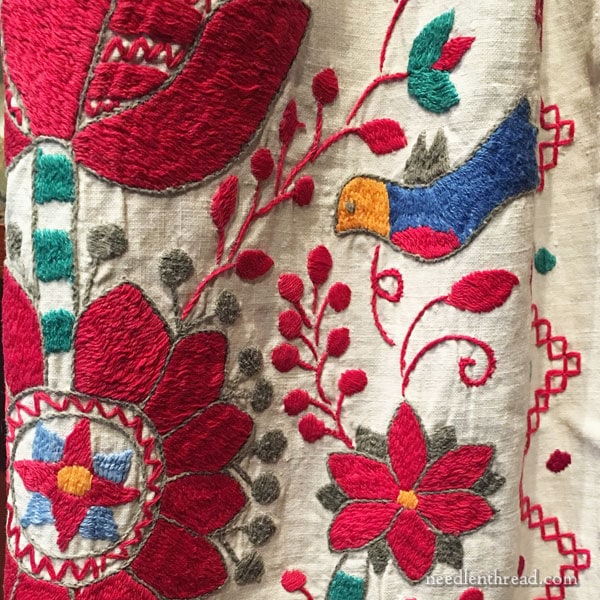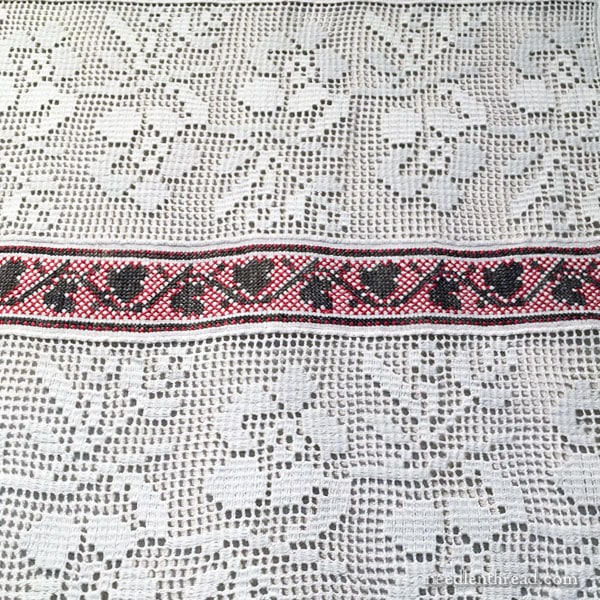So, I’ve been traveling about in the Northeast lately, where I met up week before last with my six sisters and spent a splendid time (albeit too short!) hanging out together.
After we dispersed as a group, I continued my excursions.
One of my sisters recommended a visit to the Museum of Russian Icons in Clinton, Massachusetts.
I thought it was somewhat odd that there was a Russian icon museum in Clinton, MA, and so my curiosity was piqued. I looked it up, and sure enough – there is one. It’s a well-known museum with a fantastic collection of icons. But, better yet, they’re currently running an exhibit (until June 3rd) that made me doubly eager to go: Rushnyky: Sacred Ukrainian Textiles.

The Museum of Russian Icons is a world-class museum. Don’t expect some little rinky-dink, haphazard collection, just because it’s in a relatively small city. The extent of the icon collection, coupled with the instructional information available with the self-guided audio tours (a docent was not available the day we went) was as good as any museum I’ve ever visited in any major city. If you have an interest in iconography, it is a fantastic place to visit.

It probably won’t surprise you, though, that I spent a good bit of my time there exploring the rushnyky exhibit and examining these beautiful Ukrainian textiles.
The rushnyk is a long (very long) rectangular cloth – I think most of the ones I saw were linen, though apparently they have also been made from hemp – elaborately embroidered. The cloths are traditionally used for life’s rituals, from birth to death. A newborn baby is laid upon the rushnyk; the rushnyk is used in wedding ceremonies; and at the end of life, the rushnyk is laid across the coffin or used to lower the coffin into the grave.
It’s a cloth that has deep roots in Ukrainian traditions. The colors and figures on the cloth are often symbolic, with red, symbolizing life, a dominant color.

There are different types and qualities of rushnyky displayed in the exhibit.
The more intricately embroidered convent rushnyky (or chernichyi), worked in various non-counted stitches, with Romanian couching (self-couched long satin stitches) figuring greatly in the larger filled areas, caught my eye right away.
Interestingly, cross stitch didn’t become prominent in Ukrainian folk embroidery until the later 1800’s, and the convent rushnyky – rushnyky stitched by nuns in orthodox convents, especially in the lands surrounding the Dnipro River – never feature cross stitch.

But cross stitch figures heavily in other rushnyky from the later 1800’s onwards.
Cross stitch was popularized – to the detriment of many traditional regional stitching techniques and styles – throughout Russia and the Ukraine, thanks to a French soap manufacturer.
In 1864, a Frenchman named Henry Brocard established a perfume and soap factory in Moscow. To help market his inexpensive glycerin soap, he included cross stitch patterns (usually floral) in the soap packages. The patterns were very enthusiastically received, the cross stitch trend spread even to very remote villages, women’s magazines started printing cross stitch patterns of all sorts to boost circulation, and pretty quickly, cross stitch supplanted many traditional Ukrainian regional stitching techniques and designs.
I was interested to learn that, when we see Ukrainian cross stitch designs today, they aren’t the real tradition of Ukrainian embroidery. Cross stitch didn’t figure into Ukrainian embroidery until after the 1860’s, and it was essentially adopted from the French. The convent rushnyky are more typical of traditional Ukrainian techniques.

Red and black figure pretty heavily in the embroidered rushnyk.
On many of the exhibition pieces, the red is still quite vibrant, and so is the black, but here and there, on the older pieces, you’ll see that the red is somewhat faded and the black is more grey.

Prior to the introduction of mercerized embroidery cottons in the latter decades of the 1800’s by DMC (again, a little French influence!), the cottons used were often hand dyed. With the advent of mercerized cotton, a wider array of vibrant colors were incorporated into Ukrainian folk embroidery.
Still, red and black dominate the color schemes on all of the rushnyky. While you’ll occasionally see splashes of other colors, there is never an absence of red and black.

Some of the cross stitch designs are used to great effect as borders. This was one of my favorite borders on a cross stitched rushnyk. I like the lacier look achieved by the spacing between the stitches.
The linen ground fabric for the rushnyky, incidentally, is very closely woven, and pretty fine, even in the hand-woven examples. Most of the cross stitch is worked over three threads of linen, from what I could see.

Throughout the exhibit, you’ll find quite a few examples of Merezhka, a drawn thread technique common to the central Ukraine.
Basically, groups of threads are removed from the ground cloth, and the remaining threads are wrapped and worked to create an open net-like structure that is then laced with a design.

Merezhka bands create a lace effect on the ends of the rushnyky that feature them.
There are also some lovely examples of intricate edge work leading into handmade tassels on the ends of many of the rushnyky in the exhibit, especially those featuring merezhka drawn thread techniques.
The small museum shop offers several books on Ukrainian embroidery techniques and styles, and of course, I had to pick up one or two!
The exhibit is not huge, but if you have an interest in folk embroidery, it is certainly worth seeing and contemplating!
As I scrolled through my phone, I realized I didn’t take any pictures of the modern rushnyky featured in the exhibition, but it does bring the rushynk up to today, showing contemporary examples of mass-produced, machine embroidered rushnyky. They aren’t quite as impressive!
So, if you live in the area or you’ll be in the Boston area very soon and you have an interest in folk embroidery, now would be a good time to visit the Museum of Russian Icons in Clinton, MA.
It was a pleasant way to spend a morning and a really happy surprise!
Hope your week’s off to a great start!







Thank you very much for this interesting article Mary! Crossstitch world-domination through French soap; very original :). And how interesting that the red-and-black crossstitch in use now, is often seen as ‘traditional’. But I suspect that is the same in other places. For instance, the traditional Bavarian suspenders are not stitched in petit point on canvas. They were surface embroidery. They were made several generations ago and than the easier petit point was introduced, so now that’s the new traditional.
Fascinating, thanks very much.
Hi, I am an Ukrainian women, i live in Montreal. I want to show you the modern rushnykies with was made by my friends for different occasions. I do not speak English very well, I am in french part of Canada.
I do not know how to add pictures…
Dear Mary
I hope you had a great break and I glad you able to meet up with your sisters that must have been lovely. These Ukrainian embroidered pieces are really lovely and so vibrant, I love the red bold designs and it’s lovely to think that they were used from birth to death. It would be great to copy some of the designs and embroider them in the bold red colours they would look lovely on clothes such as trousers or blouses. Thanks for sharing with us these lovely bold pieces of Ukrainian cloths I really like them.
Regards Anita Simmance
Beautiful! Thanks for taking us on an armchair trip to see these lovely pieces. Hope you get a chance to go the Met in NYC for their new exhibit.
Fascinating and beautiful! Thank you, Mary, for taking us on this tour of Ukraine rushnyk embroidery. Folk embroidery is a particular favorite of mine.
I find myself imagining the sun-darkened, rough hands of the women who created these pieces, women who worked in dim candlelight and cold rooms long after their many hours of household and farm chores were finished. How long it must have taken to create one of these exquisite pieces! I admire these women and their creations. Thanks again for taking the time to showcase their work.
Thank you from Ukraine.
Thanks so much for sharing these pictures today, Mary. I’m married to a Ukrainian man and we’ve inherited cross-stitched items from his parents, but everything they gave us (including sets of dishes) use the later black and red cross-stitching and none of the embroidery shared here (I like the embroidery better!). I just read your article to my husband (he was home for lunch), and he found the history interesting too, as all he could remember seeing in his childhood was the cross-stitched items. His grandparents immigrated from the Ukraine to New York many years ago, and when we visited NY every year in our younger years, we’d always attend the Ukrainian folk festivals. I do remember seeing the more traditionally embroidered tunics and skirts at those events, and what swirls of color appeared during the dancing! So fun to think of them all again. Thanks for stirring the memories. (P.S. Are you really going to get to see the William Morris Gallery? I’m so envious! I’m working on two WM quilts now: one that includes Beatrix Potter embroidery and the other bordered hexagons of his reproduced wonderful fabric lines.)
Hi, Cate – I’m glad you enjoyed the article! No William Morris gallery for me, I’m afraid! I’m in the US and not likely to hop over to the UK any time soon, much as I’d love to!
What a phenomenal review, and the photos were tantalizing….it makes me want to make a long cloth illustrating life events and design bits…thank you so much for the work you put into your website and the joy it brings as i travel around with you!
Mary
Thank you so much for this- great information about a topic that I knew so little about!
Judy
from Oz
It is no longer appropriate to refer to Ukraine as “the” Ukraine as it conveys this is not a country but a region. In the original language there is no equivalent article such as “the” so attributing the usage to translation, as some choose to do is innacurate. It is a leftover from a different time when Imperial Russia made every effort to denigrate the nation, the people, and the language.
From an embroidery standpoint, there is also an error regarding hand dyed colors. There is documentation that indicates that not every article with “grey” threads was embroidered with black that had faded. Black that faded to grey was actually more prevalent in mid 20th century commercially dyed threads when dyes were unreliable in the post WW2 period. When you see exemplars from that time period, and the coloring is uneven, it is a giveaway of fading especially when an article has had a fairly even exposure to light. Pre Brocard/DMC 19th century exemplars with grey threads that are consistent in color distribution were grey to begin with.
Mary – thank you so much for highlighting this Museum of Russian Icons and the special Ukrainian embroidery exhibit. We stopped by today on our way home from Boston. The embroideries are spectacular (as are the icons) and what a gem in the wooded countryside outside Boston!! I took photos of every embroidery (would send you any you need) and mentioned at the entrance how I discovered the special exhibit. Thank you so much! I might even get an EGA program together. I took an EGA correspondence course in Ukrainian embroidery many years ago but not these types with color. Thank you!!!